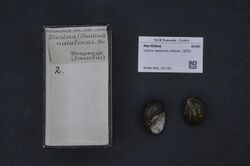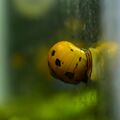Biology:Vittina natalensis
| Vittina natalensis | |
|---|---|

| |
| Vittina natalensis shells | |
| Scientific classification | |
| Domain: | Eukaryota |
| Kingdom: | Animalia |
| Phylum: | Mollusca |
| Class: | Gastropoda |
| Subclass: | Neritimorpha |
| Order: | Cycloneritida |
| Family: | Neritidae |
| Genus: | Vittina |
| Species: | V. natalensis
|
| Binomial name | |
| Vittina natalensis (Reeve, L.A., 1845)
| |
| Synonyms | |
| |
Vittina natalensis, commonly known as spotted nerite or zebra nerite,[2][3] is a species of small freshwater snail with an operculum, an aquatic gastropod mollusk in the family Neritidae, the nerites.[4] It returns to brackish waters to reproduce. This is a popular aquarium snail, sold because it looks attractive and eats algae in freshwater tanks, but can only reproduce in saltwater or brackish water conditions.[3]
Distribution
This species is endemic to the coastal plain of East Africa -- Kenya, Mozambique, Somalia, South Africa , and Tanzania.[1] Its specific name natalensis refers to the region of Natal, South Africa.
Human use
This species is a common choice of algae-eating snail among freshwater aquarists. In the aquarium trade, the striped shell of this species has caused it to be known as the tiger snail, zebra snail, or zebra nerite. (The name zebra nerite is however misleading, because there are several species of nerite that have that common name, including Puperita pupa, a small marine nerite from the tropical western Atlantic.) The stripes in some individuals may display as zigzags, dashes or spots.[citation needed] In an aquarium, the shell of this species grows to about 2.5 cm (one inch) in diameter. This snail prefers an aquarium temperature of 22 to 26 °C.[citation needed]
References
- ↑ 1.0 1.1 Appleton, C.; Kristensen, T.K.; Lange, C.N.; Stensgaard, A-S.; Van Damme, D. (2010). "Neritina natalensis". IUCN Red List of Threatened Species 2010: e.T14628A4451314. doi:10.2305/IUCN.UK.2010-3.RLTS.T14628A4451314.en. https://www.iucnredlist.org/species/14628/4451314.
- ↑ Perissinotto, Renzo; Miranda, Nelson; Raw, Jacqueline; Peer, Nasreen (2014-09-15). "Biodiversity census of Lake St Lucia, iSimangaliso Wetland Park (South Africa): Gastropod molluscs" (in en). ZooKeys (440): 1–43. doi:10.3897/zookeys.440.7803. ISSN 1313-2970. PMID 25317060. PMC 4196252. https://zookeys.pensoft.net/articles.php?id=4075.
- ↑ 3.0 3.1 "Nerite Snail (Neritina natalensis): Ultimate Care Guide". https://www.fishlaboratory.com/fish/nerite-snail/.
- ↑ MolluscaBase eds. (2021). MolluscaBase. Vittina natalensis (Reeve, 1855). Accessed through: World Register of Marine Species at: http://www.marinespecies.org/aphia.php?p=taxdetails&id=1353177 on 2021-09-26
- Eichhorst T.E. (2016). Neritidae of the world. Volume 2. Harxheim: Conchbooks. pp. 696–1366
External links
Wikidata ☰ {{{from}}} entry
 |




